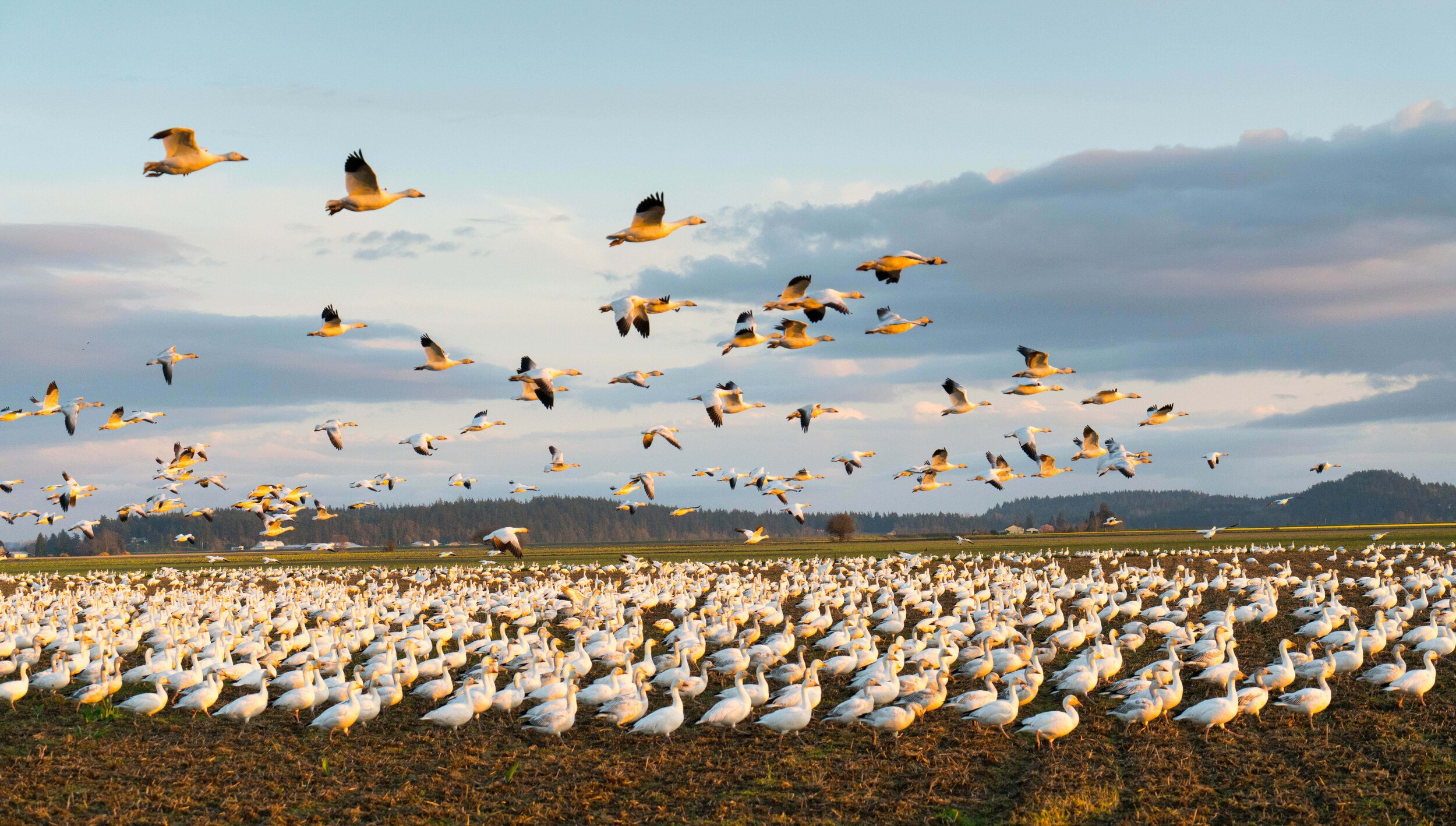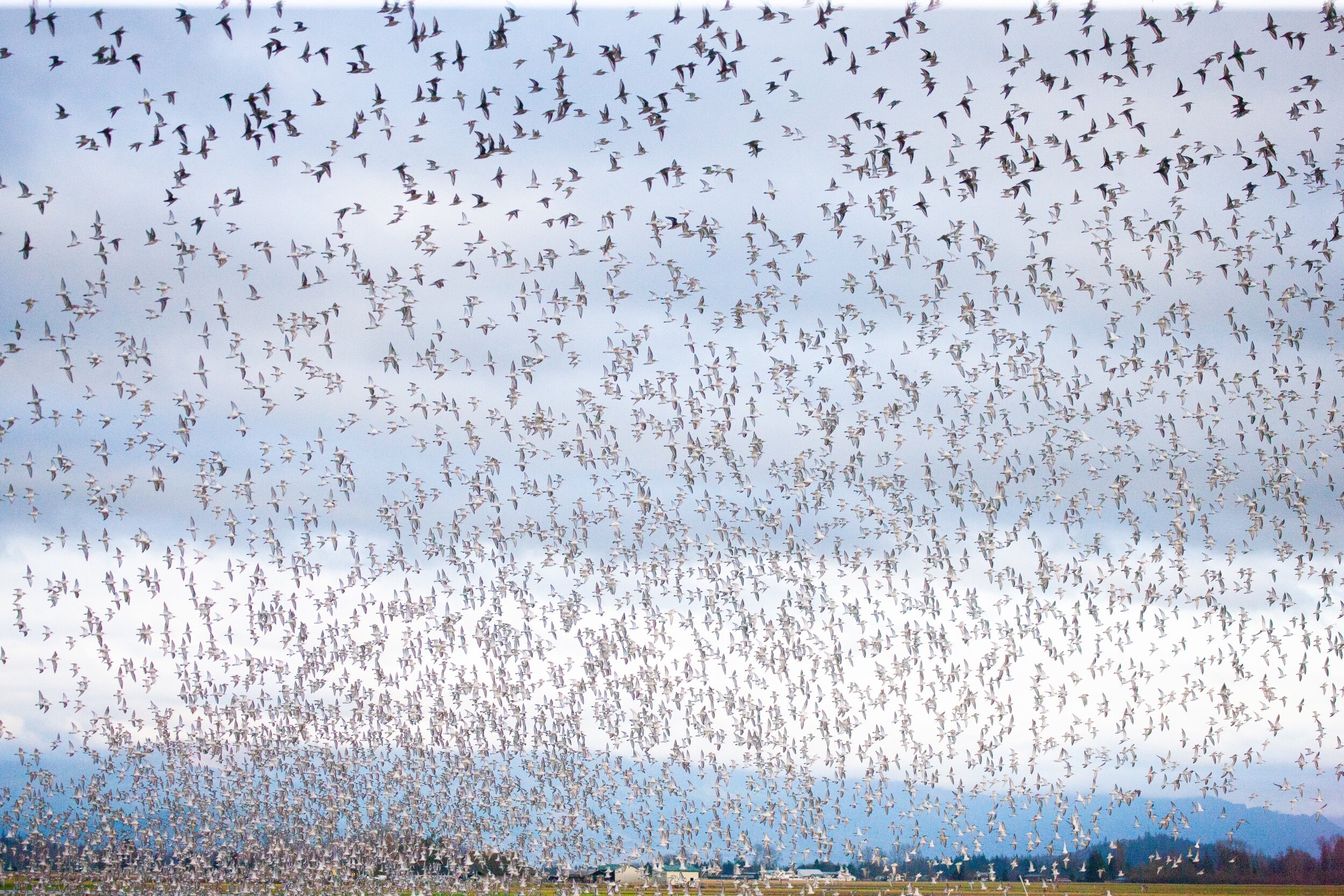Waterfowl Management on Farmland - The Dirt Issue #61
“These flocking birds attract our attention – and, unfortunately, often do real damage.”
When Natural Migration and Agriculture Use the Same Land
Tens of thousands of migratory birds spend part of their year resting and feeding on the rich farmlands of Skagit County. It's all part of the Pacific Flyway, a coast-hugging route that extends from breeding grounds in arctic tundra to more temperate winter-feeding grounds found here. For most of the birds that winter here, this area is the southern limit of their migratory loop before the progress of the seasons turns them back north.
In the millennia these populations have followed this route, their stopover sites were river deltas and wetlands all up and down the west coast. These regions were rich in a diversity of food and sufficient protection to keep bird numbers strong. In those days, and somewhat still, a percentage stayed in the area just long enough to fuel up for the trek further south into what is now Oregon and California. But the flyway has become more fragmented due to urbanization, industry and agriculture, as well as the loss of habitat from the scourge of climate change in drought and fire. The numbers of migratory birds have had to adjust their patterns. Many are forced to come here.
Nearly All Birds Are Migratory
According to the National Audubon Society, almost all the birds seen in Skagit County are migratory. While it’s said that over 260 bird species alight on the Skagit River Delta each year—the most-favored area in the county for migrating birds—the ones that have the greatest impact on local agriculture are the well-known snow birds that come to the area in mid-fall and stay until early spring.
Chief among them are a 50,000-strong population of Lesser Snow Geese and 10-12,000 swans, two-thirds of which are Trumpeter Swans and one-third Tundra Swans. These flocking birds attract our attention—and, unfortunately, often do real damage.
Eagles prey on snow geese, whose flocking habit is, in part, a defense mechanism. When you see a flock of snow geese rise from the earth as if of one mind and move in undulating waves just like a shoal of fish (a phenomenon known to birders as a murmuration), they are often employing the strategy to thwart a predator. An eagle cannot pick out a target bird when the whole flock is airborne at once.
Natural Protection Methods Intensify Potential Damage
But this habit of protecting themselves by their sheer numbers also means they feed as a flock. If you're a dairy farmer and a flock lands on pasture with the first flush of tender green grass shoots, you can easily see your entire crop decimated by these hungry visitors. You'd not only lose, at a minimum, the first growth intended to feed your dairy cows, but you may also be forced to purchase supplemental feed to cover the loss. This is not an insignificant issue.
What's a Farmer to Do?
The dairy farmer is just one type of farmer for whom the birds bring negative, often very costly, harm. They not only eat new grass shoots, but they destroy cash crops planted in the fall and meant to overwinter for spring harvest. Droppings from thousands of waterfowl are washed into drainage infrastructure by the fall-to-spring rains. This natural effluent can lead to a fecal coliform bacteria issue that contributes to high fecal levels in local bays.
Add to all this the human factor: hundreds of enthusiastic bird watchers who cause traffic snarls while trying to hug the verge between road and fields and fail to respect fences and gates on private farmland as they pursue the perfect photo op. The Skagit Delta contains both private and public lands; unfortunately, many viewers fail to observe the distinction despite clearly posted notices.
Some Farmers Benefit
By no means do all farmers suffer losses from migrating waterfowl. Some famers allow bird hunting on their land. Sometimes it's public access, sometimes it's private duck clubs, but access is granted in return for a fee or other economically viable incentive. Some farmers are paid to plant forage specifically for the birds. Other farmers experience a more neutral outcome from the birds; their fields are fallow anyway or their winter cover crop is planted for other reasons and the foraging birds don't matter.
Finding Common Cause
Many farmers are willing to make at least some of their farmland a safe place for wintering birds. Fortunately, potential incentives may make such an effort viable. The challenge is getting the balance right.
Case in point: Since the 1950s the Washington Department of Fish and Wildlife (WDFW) has managed the Skagit Wildlife Area Island Unit to produce crops for over-wintering waterfowl. The 270-acre site is comprised of two islands in a reach of the South Fork Skagit River. It has long been a favorite haunt of waterfowl hunters. Now, the WDFW is proposing to convert the entire site to estuary habitat for rearing juvenile Chinook salmon.
As an estuary, the site will no longer be able to support the waterfowl population that is accustomed to returning to it year after year. Farmers are justifiably concerned that this will drive even more waterfowl onto their fields.
How Do You Balance That?
WDFW can opt to open up their hunting program to pay more farmers for hunting access. They can provide a fund to compensate farmers when birds damage their crops. They can pay more farmers to grow forage. They can even initiate a scheme to lease farmland for habitat for a three-year period, then lease elsewhere while the original acreage is placed back in agricultural rotation.
Habitat rotation can be a revolutionary method to harmonize the needs of agriculture and conservation. Not every farmer can participate but when enough do, the region overall is able to provide habitat and protection for Lesser Snow Geese, Trumpeter Swans, Tundra Swans, Mallards, American Wigeon, Green-winged Teal, and scores of other visiting migrants who help in so many ways to make our region the wondrous place it is.
By Teresa Bennett: info@skagitonians.org
Photo credit: Gary Brown



